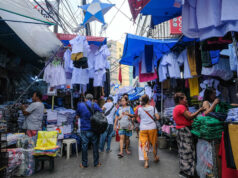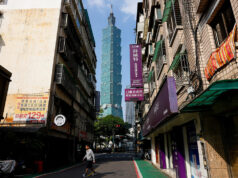JUDICIOUS editing, restraint, a respect for diversity, and a love for local brought impossible heights of chic at the regional fashion show of Panasonic Manila Fashion Festival last week, featuring designers from Cebu and Davao.
The show was opened by Aztec Barba, showing a collection of dresses featuring flowy silhouettes, making use of drab colors like gray and charcoal, spiced up with pops of color in jade and emerald green. Some of the outfits, such as a cape, featured interesting dye techniques that gave the fabric individual character. Next up was Bamba Limon, who showed a collection of dresses and menswear made of pastels, and trimmed with fabrics woven by indigenous people. The cleanliness of cut and silhouette provided a pastoral peacefulness to the clothes. Benjie Panizales, meanwhile, showed off a collection of black and white garments made with fabrics printed with a design from the Bagobo indigenous people. Dodjie Batu then showed a collection of neutral-toned menswear, with gray as a prevalent hue. It’s an exercise in experimentation with shirts for example, not buttoned, but draped and wrapped around a man a la Diane von Furstenburg, but still entirely clean and refreshingly masculine.
Emi Englis showed designs that bordered on the avant-garde, with clothes made with the repeated motif of ovals: not as a print, mind you, but an overall silhouette and pattern. Think of a top with a Mandarin collar for women that lands oh-so-softly on a woman’s waist, cut as an oval, or else a two-toned coat that appeared as an egg, until the models arms pop out of the sides of the sleeves, which were integrated with the rest of the garment, like a draped raglan sleeve — with the renewed use of her arms, she took her coat off to the oohs and aahs of the audience.
Another designer who stood out was Edgar Buyan, who showed clothes printed wit the faces of different indigenous peoples from Mindanao, as well as articles about them, with experiments in shape such as a coat with loose butterfly sleeves and a bodice that appeared like a cocoon on the torso. For this collection, Mr. Buyan dedicated his show to the indigenous people from whom he had borrowed.
As for the question of cultural appropriation, most of the designers assured this reporter that they had taken seminars about proper appropriation from the National Commission on Culture and the Arts. For example, since the indigenous peoples’ culture and tradition had prevented them from cutting the actual fabric since it was sacred to them, they were at least allowed to replicate the patterns by printing them.
Another designer who caught the eye was Windell Mira, who created a series of clothes made with mesh, and if one observed the fabrics underneath them, were printed with designs of varicolored banig (woven mats), the pattern of which was borrowed from the Badjao people.
Philipp Tampus, meanwhile, showed a collection that could be summarized with the word “rich”: think richly patterned black lace, reminiscent of Spanish mantillas, paired with flame-colored skirts, especially in one inspired by flamenco which swished appealingly while it went down the runway on a model. Finally, Philip Rodriguez ended the show with a collection of Belle Epoque-inspired dresses made with tulle and embroidered with dainty flowers, lending a distinctly feminine touch. — Joseph L. Garcia



